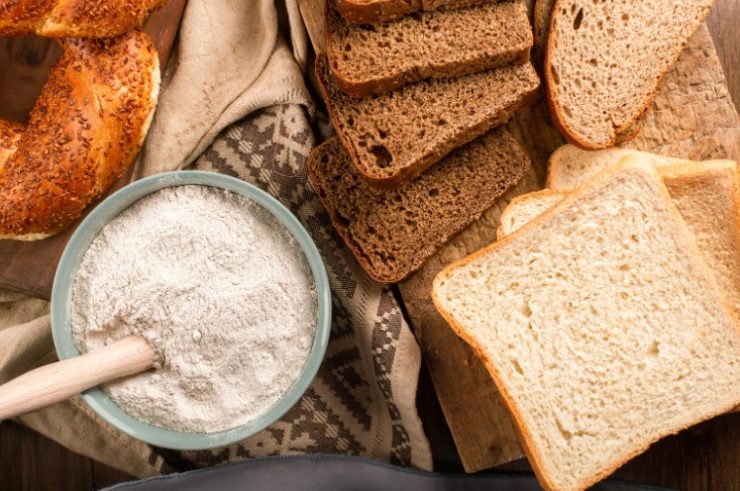Compared to other common flours, bread flour is high in gluten, with a protein (gluten) content of 12-14%. It’s the top choice for all artisan breads.
The high protein content is also what makes bread flour difficult to substitute.
Through my background as a pastry chef and cook, I’ve worked with bread dough in many contexts. Since its high protein content makes for stronger, more elastic gluten strands, it’s my first choice for stretchy doughs. It’s ideal for pizza dough, focaccia, and English muffins.
Bread flour also creates the chewy texture you’ll find in baguettes and bagels. But it’s not an ideal flour for pastries, cakes, or cookies–the high gluten content will make them too dense and tough.
The magical stretchy quality of bread flour gets amplified when you knead your dough. The kneading creates web-like networks of gluten strands within. When it’s finally baked, the networks of gluten trap the rising air bubbles. This results in that light, chewy texture that all bread lovers crave.
If you’ve ever run out of bread flour, or didn’t want to buy a new flour for a project, this article lists 5 substitutes to try.
In This Article
5 Ideal Substitutes for Bread Flour
All-Purpose Flour
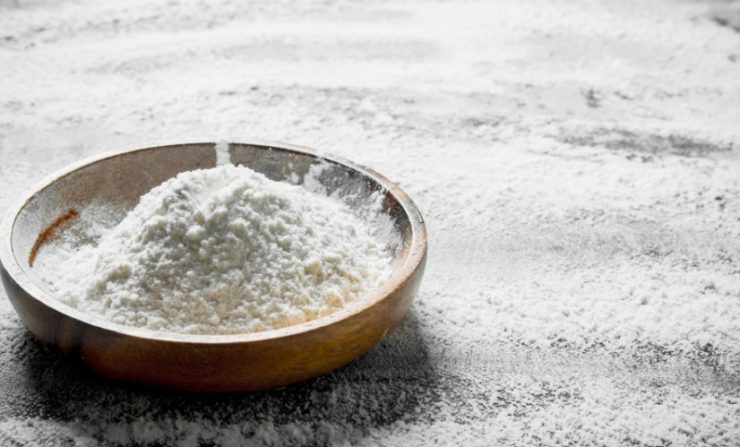
All-purpose flour is the simplest substitute for bread flour. It has the closest protein content at 10-12%. This substitute can work well in any baking recipe that calls for bread flour.
Be aware that all-purpose flour might leave you with a less chewy end product. Your baked items may not rise quite as high and can be a little bit denser.
Regardless, most items will bake up similarly with a 1:1 ratio of all-purpose flour to replace bread flour. I’d recommend substituting flours by weight rather than volume. This is since bread flour weighs more than all-purpose. (One cup of all-purpose flour weighs about 128 grams.)
For baked items like bagels that can’t go without that super-chewy texture, read on to the next list item.
Add Gluten to All-Purpose Flour
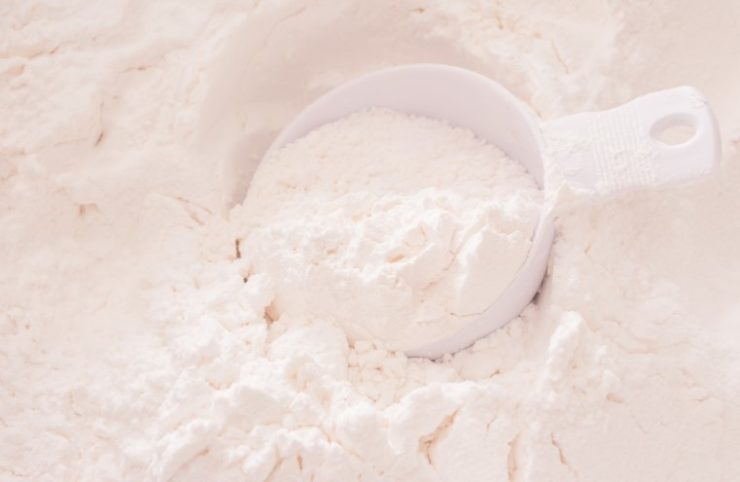
For bread flour recipes that need a chewy texture, you can add gluten to all-purpose flour. This combination bakes up much like bread flour.
The added gluten creates a protein content closer to bread flour. So this substitution can work wonders for any flatbread, artisan bread, or pizza dough. It would also be great for bagels and pretzels.
To use this substitute, add 2 teaspoons of vital wheat gluten to every cup of flour. Mix it together and use at a 1:1 ratio to bread flour.

Pro Tip: When possible, measure by weight instead of volume when substituting flours. This is because all flours have unique weights.
Whole Wheat Flour + All-Purpose Flour
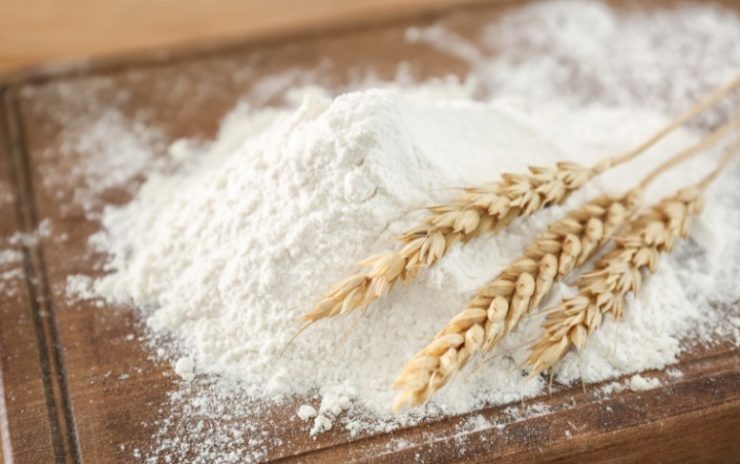
Are you wanting a hearty, nuttier taste in your bread flour substitute? Or are you substituting whole wheat bread flour? Then this combination of whole wheat and all-purpose flour is for you.
While this is a tasty substitute, you will need to think about a few things to ensure a good final product.
Whole wheat flour still contains the bran and germ. This boosts the fiber and nutrient content of the flour. Unfortunately, the little bits of bran are sharp. In bread dough, they act like tiny blades that can cut the gluten strands that bakers work so hard to develop.
If you decide to use this substitute, start with a ratio of 50% whole wheat and 50% all-purpose flour. Before you measure your whole wheat flour, sift out and discard the bran to get the best rise during baking.
If your bread comes out too flat and dense, you can add vital wheat gluten to this combination. Or you can cut the percentage of whole wheat flour down to 25% and replace the rest with all-purpose flour.
“00” Flour
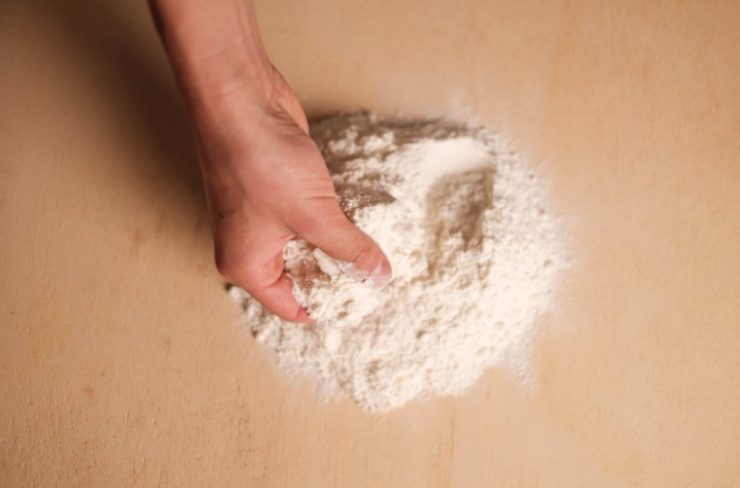
A harder-to-find flour, “00” flour is Italian superfine wheat flour. Made from durum wheat, it has a soft, silky texture like baby powder. If you need to make a killer pizza dough without bread flour, 00 is the way to go.
00 flour has a gluten content of around 11% (this varies by brand). You can expect a consistent and smooth dough with good stretchiness. Because it’s so finely milled, it has the elasticity of bread flour without getting too tough.
“00” flour is typically used in Italy to make pasta and Neapolitan pizza dough. Neapolitan pizzas are known for their thin, crispy crusts. If you use this substitute at a 1:1 ratio for bread flour, your crust may come out crispier.
Experiment with Flour Combinations
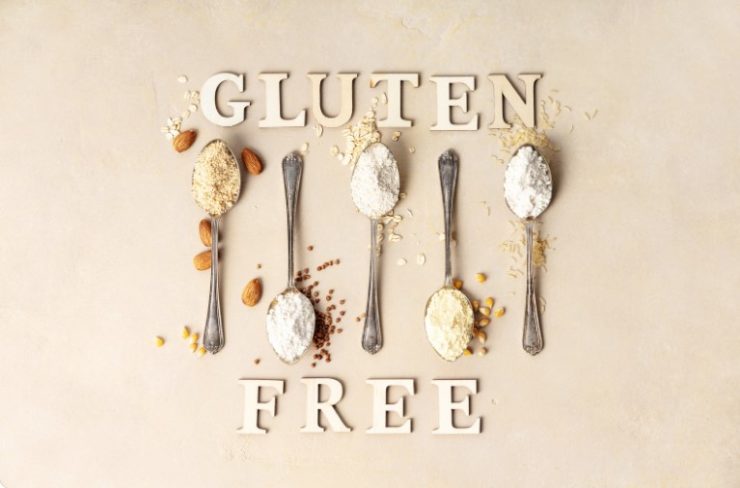
Are you feeling adventurous? Since there are more types of flour in the world than I could ever cover here, I’d like to encourage you to experiment!
Depending on what type of recipe you need a bread flour substitute for, your options are endless. For flours that you’re not familiar with, you may need to do some research. You’ll want to determine their gluten content (if any) and how they function in recipes.
If you’re new to substituting flours, stick to using 50-75% all-purpose flour in your recipes. Each type of flour will contribute its own taste and texture, so play around to find what you like best.
Heavy grains need extra gluten to support their rising during fermentation and baking. You may need to add vital wheat gluten if you want to use grains like rye, barley, or cornmeal in your bread.
Have you decided to bravely venture into the world of gluten-free baking? I’d recommend finding gluten-free specific recipes to start with instead of a classic bread recipe. Gluten-free baking has its own loose set of rules and is still considered the “wild west” of baking!
Some of the flours you can experiment with include:
- Rye
- Barley
- Semolina
- Spelt
- Cornmeal (gluten-free)
- Buckwheat (gluten-free)
- Amaranth (gluten-free)
- Rice Flour (gluten-free)
- Chickpea Flour (gluten-free)
- Almond Flour (gluten-free)
Final Thoughts On Substituting Bread Flour
When you need to substitute bread flour, a 1:1 replacement with all-purpose flour is your easiest bet. Its protein content is close enough to bread flour to give you results you’ll be happy with.
Thanks to modern food science, you can always add vital wheat gluten to your recipe if needed. If you can get close to the protein content of bread flour, you’ll have a more similar end result.
Finally, don’t be afraid to take some chances if you have the time and resources. Learn what you can about new flours before using them, then start small. Use 50-75% all-purpose flour and try alternative flours to substitute the rest.
Frequently Asked Questions
What’s the easiest substitute for bread flour?
Replace bread flour with all-purpose flour at a 1:1 ratio for the easiest substitute. Your bread may not turn out quite as chewy as with bread flour.
Is self-rising flour the same as bread flour?
No. Self-rising flour contains baking powder and salt, and is intended for non-yeasted baked goods and pastries. Do not use self-rising flour to substitute bread flour.
What is the closest substitute to bread flour?
To get a close substitute to bread flour, use all-purpose flour at a 1:1 ratio. Then add 2 teaspoons of vital wheat gluten per each cup of flour.
